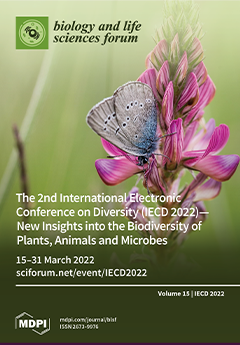Biodiversity is an indispensable resource and contributes to the balance of ecosystems, being of great importance for the development of a society and its culture through good management of natural spaces. However, the reduction in and fragmentation of habitats, trafficking, and illegal trade
[...] Read more.
Biodiversity is an indispensable resource and contributes to the balance of ecosystems, being of great importance for the development of a society and its culture through good management of natural spaces. However, the reduction in and fragmentation of habitats, trafficking, and illegal trade in wild animals affect the great diversity of wild flora and fauna that characterize Peru. Considering this problem, we modeled the biogeographic distribution of five species of wildlife categorized as threatened by Peruvian legislation and included in the red list of threatened species of the International Union for the Conservation of Nature (IUCN): critically endangered (CR)
Lagothrix flavicauda, endangered (EN)
Aotus miconax, in vulnerable-status (VU)
Tremarctos ornatus and
Lagothrix cana, and in the near-threatened category (NT)
Panthera onca. Our study aimed to identify their current potential distribution in the Peruvian territory which is legally protected by the conservation areas of national, regional, or private administration. In this regard, we used a maximum-entropy approach (MaxEnt), integrating 14 variables (7 bioclimatic variables, 3 topographic, 3 variables of vegetation cover, and relative humidity). It was observed that 3.6% (46,225.50 km
2) of the Peruvian territory presented a high probability (>0.6) of distribution of the evaluated species and 10.7% (136,918.28 km
2) of moderate distribution (0.4–0.6). Based on this, our study allowed us to identify the geographical spaces for threatened species on which conservation actions should focus, through the formulation of strategies, plans, policies, and participatory management in the Peruvian territory.
Full article



